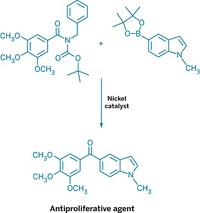Advertisement
Grab your lab coat. Let's get started
Welcome!
Welcome!
Create an account below to get 6 C&EN articles per month, receive newsletters and more - all free.
It seems this is your first time logging in online. Please enter the following information to continue.
As an ACS member you automatically get access to this site. All we need is few more details to create your reading experience.
Not you? Sign in with a different account.
Not you? Sign in with a different account.
ERROR 1
ERROR 1
ERROR 2
ERROR 2
ERROR 2
ERROR 2
ERROR 2
Password and Confirm password must match.
If you have an ACS member number, please enter it here so we can link this account to your membership. (optional)
ERROR 2
ACS values your privacy. By submitting your information, you are gaining access to C&EN and subscribing to our weekly newsletter. We use the information you provide to make your reading experience better, and we will never sell your data to third party members.
Synthesis
New amination chemistry brought to light
Photogenerated radical cations yield amines previously impossible to make
by Bethany Halford
February 16, 2017
| A version of this story appeared in
Volume 95, Issue 8

Flashes of light help chemists at Princeton University and Bristol-Myers Squibb drive the hydroaminations of olefins to produce substituted amines. The light-powered reaction gives chemists another tool for installing amines in drugs and other biologically important molecules.
The new hydroamination is noteworthy for its intermolecular reactivity, its use of unactivated olefin substrates, its toleration of several different functional groups, and its regioselectivity for anti-Markovnikov amine products—wherein the new C–N bond forms on the less substituted carbon of the olefin (Science 2017, DOI: 10.1126/science.aal3010). Most other examples of hydroaminations result in products with the opposite, Markovnikov regiochemistry. What’s more, the new reaction can produce highly substituted amines (such as in the example shown) that are impossible to make any other way.
In the reaction, irradiation of a secondary alkyl amine in the presence of an iridium catalyst and a thiol cocatalyst yields an aminium radical cation intermediate. This species is responsible for the reaction’s anti-Markovnikov regiochemistry and highly substituted products, explains Robert Knowles, who led the research effort. “These alkyl aminium radical cations are highly reactive and will add to many olefin classes with extraordinarily fast rates, allowing us to achieve these types of intermolecular hydroaminations.” he says.
“Knowles came up with an elegant approach to what was really an unsolved problem,” comments Kami L. Hull, an expert in anti-Markovnikov hydrofunctionalization at the University of Illinois, Urbana-Champaign. Previous examples of anti-Markovnikov hydroaminations, she points out, either required activated olefins or directing groups, or produced stoichiometric amounts of unwanted by-products. Furthermore, Hull adds, Knowles’s olefin substrates are so energetically stable that they wouldn’t react without his photocatalytic approach, which really expands what chemists can do with this reaction.





Join the conversation
Contact the reporter
Submit a Letter to the Editor for publication
Engage with us on Twitter